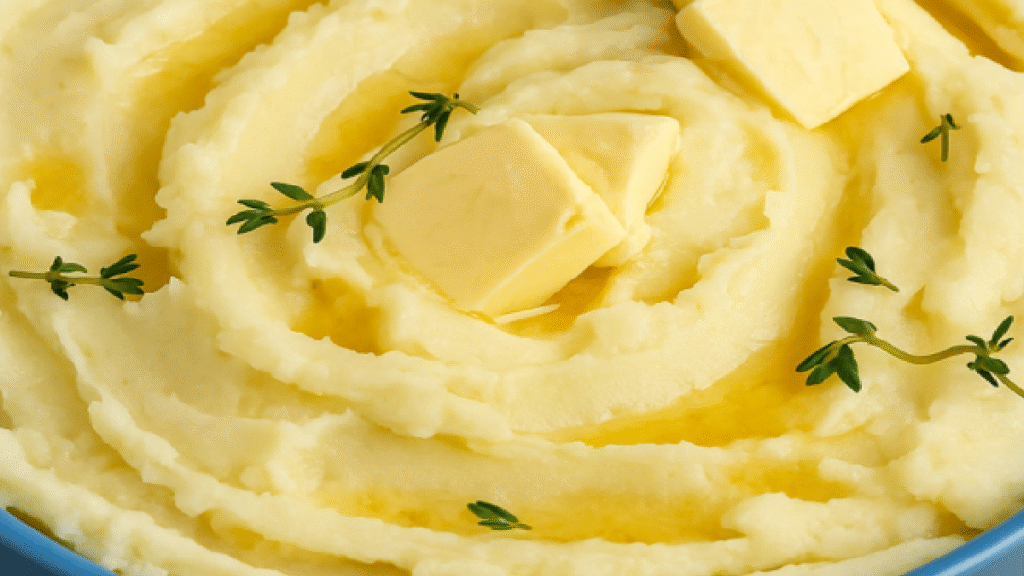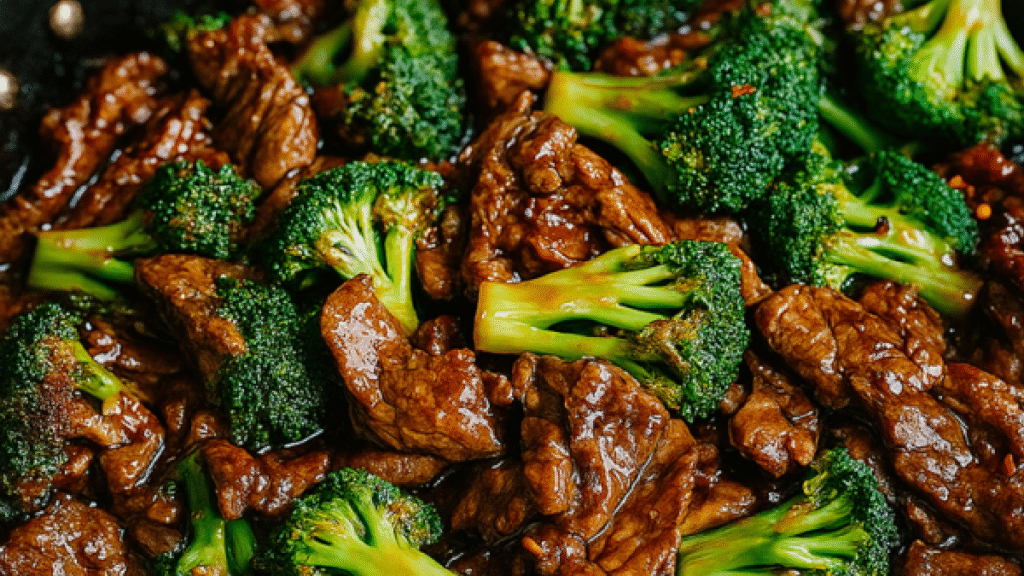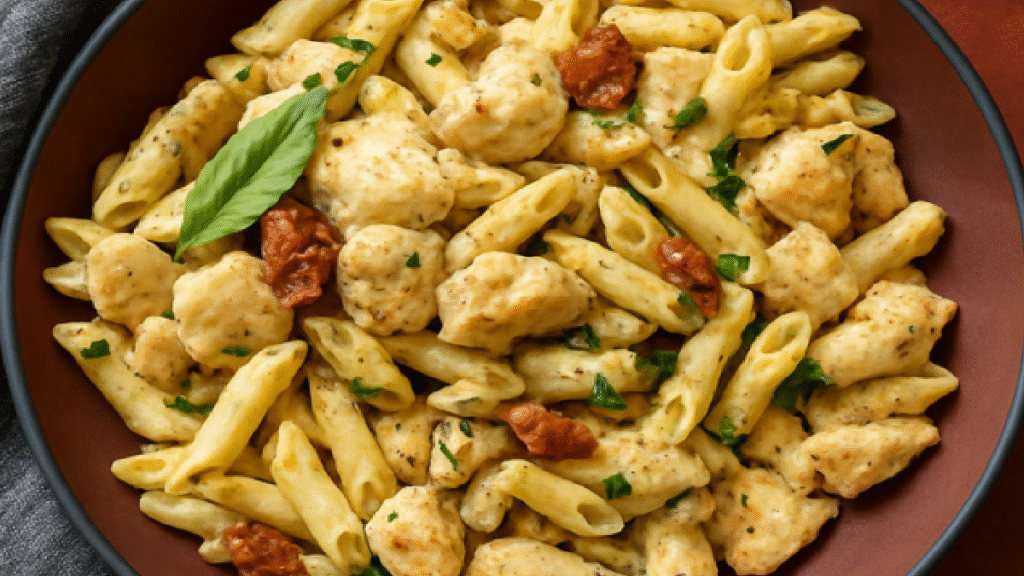Mashed potatoes are a beloved side dish that can elevate any meal. A great mashed potatoes recipe is a treasured find, and we’re excited to share our favorite version with you.
Whether you’re hosting a dinner party or simply craving a comforting classic, our best mashed potatoes recipe is sure to become a staple in your kitchen. With a few simple ingredients and some expert tips, you’ll be on your way to creating the creamiest, most delicious mashed potatoes you’ve ever tasted.
Key Takeaways
- Simple ingredients for a delicious outcome
- Expert tips for the creamiest mashed potatoes
- A versatile side dish for any occasion
- Perfect for dinner parties or family meals
- Easy to make and customize to your taste
The Secret to Extraordinary Mashed Potatoes
To elevate mashed potatoes from mundane to magnificent, one must delve into the science of achieving the ideal texture and creaminess. The art of making mashed potatoes that are both delicious and visually appealing hinges on understanding the underlying principles that govern their preparation.
The Science of Creaminess
The creamy texture of mashed potatoes is primarily achieved through the breakdown of starches in the potatoes. When potatoes are cooked, the heat breaks down the starch granules, making them more accessible to fat molecules from ingredients like butter and milk. This combination results in a smooth, creamy consistency. For more insights into preparing potatoes, you can explore recipes like pommes de terre au four, which highlight the versatility of potatoes in French cuisine.
Texture Fundamentals
Achieving the perfect texture in mashed potatoes involves balancing the degree of mashing with the type of potatoes used. Potatoes high in starch, like Russet or Idaho, yield a lighter, fluffier mash, while waxy potatoes result in a denser, more moist product. The key is to mash the potatoes just enough to break down the cells without making them gluey or unappetizingly lumpy.
Mashed Potatoes in French Culinary Tradition
In the realm of French culinary tradition, mashed potatoes, or ‘pommes purée,’ hold a special place. This dish, while simple in concept, has been elevated to an art form by French chefs.
Historical Development
The history of mashed potatoes in French cuisine is rooted in the country’s rich culinary past. Originally a peasant food, mashed potatoes evolved into a sophisticated dish served in fine dining establishments. French culinary techniques transformed this humble dish into a luxurious experience.
Influence of French Master Chefs
French master chefs have played a significant role in shaping the identity of mashed potatoes in French cuisine. Their innovations and techniques have contributed to the dish’s evolution.
Joël Robuchon’s Famous Pommes Purée
Joël Robuchon, a renowned French chef, is famous for his pommes purée. His technique involved using high-quality potatoes, precise cooking methods, and generous amounts of butter, resulting in a creamy, luxurious dish. Robuchon’s pommes purée set a new standard for mashed potatoes worldwide.
Modern French Interpretations
Today, French chefs continue to innovate with mashed potatoes, incorporating new flavors and techniques while maintaining the core principles of French cuisine.
This blend of tradition and innovation keeps mashed potatoes relevant in modern French culinary tradition.
Choosing the Ideal Potato Varieties
The journey to perfect mashed potatoes begins with selecting the right potato variety. Different potato varieties have distinct characteristics that affect the final texture and flavor of your mashed potatoes.
French Potato Varieties
France offers a diverse range of potato varieties, each with its unique qualities. For mashed potatoes, certain varieties stand out.
Ratte and Charlotte Potatoes
Ratte and Charlotte potatoes are popular in French cuisine. Ratte potatoes are known for their nutty flavor and firm texture, while Charlotte potatoes offer a buttery taste and smooth texture. Both are excellent choices for mashed potatoes due to their high starch content and ability to hold their shape when cooked.
Bintje and Other Local Options
Bintje potatoes, another French favorite, have a high starch content, making them light and fluffy when mashed. Other local options like Agria and Monalisa are also worthy considerations for their flavor and texture profiles.
Starch Content and Texture Results
The starch content in potatoes significantly impacts the texture of mashed potatoes. Potatoes with high starch content, like Bintje, yield a lighter, fluffier mash, while those with lower starch content may result in a gluey or sticky texture. Understanding the starch content and how it affects the final texture is crucial for achieving the perfect mash. For more insights on achieving perfect results in baking, visit Buzzito’s guide on cookies.
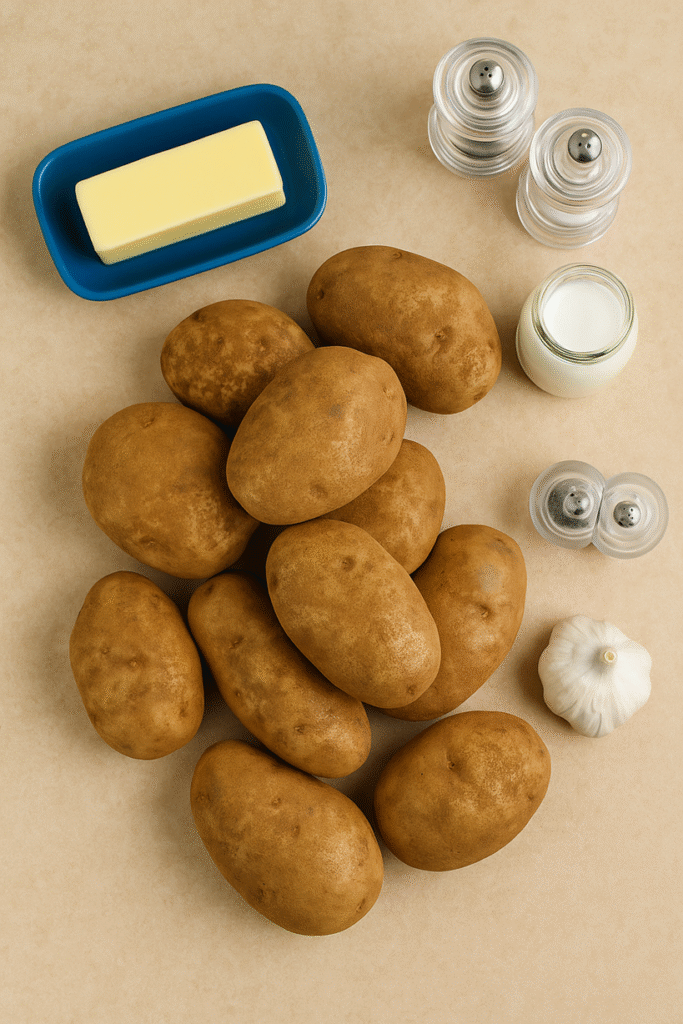
By choosing the right potato variety and understanding its starch content, you can significantly enhance the texture and flavor of your mashed potatoes, making them a delightful side dish for any meal.
The BEST Mashed Potatoes Recipe: Ingredients Breakdown
Creating the best mashed potatoes recipe starts with understanding the importance of high-quality ingredients. The right combination of elements can elevate this classic dish to new heights.
Premium Butter Selection
When it comes to making exceptional mashed potatoes, the choice of butter is crucial. The type of butter used can significantly impact the flavor and texture of the dish.
French Butter vs. American Butter
French butter, known for its rich, creamy flavor, can add a luxurious touch to mashed potatoes. In contrast, American butter tends to have a milder taste. For a more authentic French culinary experience, consider using French butter in your recipe.
Salted vs. Unsalted
The decision between salted and unsalted butter depends on personal preference and the overall seasoning strategy. Unsalted butter allows for more control over the salt content, while salted butter can enhance the flavor profile.
Dairy Options for Richness
The choice of dairy products plays a significant role in achieving the desired richness and creaminess in mashed potatoes.
Crème Fraîche and Heavy Cream
Incorporating crème fraîche or heavy cream can add a luxurious texture to mashed potatoes. Crème fraîche contributes a subtle tanginess, while heavy cream provides a rich, velvety smoothness.
Whole Milk and Half-and-Half
For a lighter version, whole milk or half-and-half can be used. These options still offer creaminess without the heaviness of heavy cream.
Seasoning with French Flair
Seasoning is a critical step in creating flavorful mashed potatoes. Incorporating traditional French herbs and spices can give the dish a distinct character.
By carefully selecting and combining these ingredients, you can create a truly exceptional mashed potato recipe that showcases the best of French cuisine.
Essential Kitchen Equipment
Preparing the best mashed potatoes requires not just quality ingredients, but also the right kitchen equipment. The tools you choose can significantly impact the final texture and flavor of your dish.
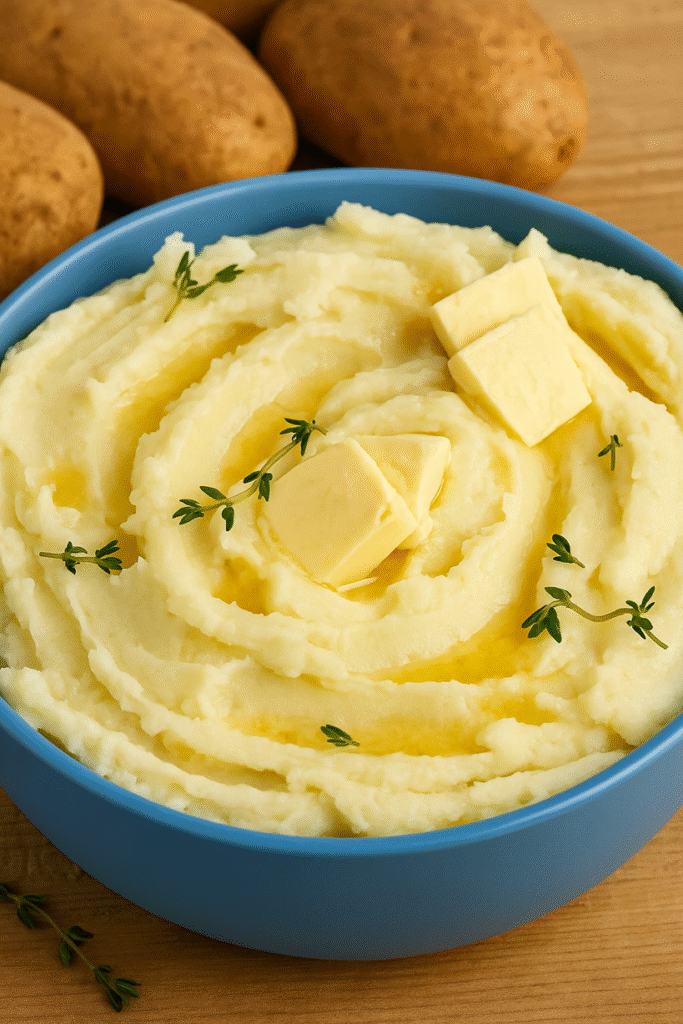
Mashing Tools Comparison
When it comes to mashing potatoes, the tool you use can make a big difference. Let’s compare some popular options.
Traditional Potato Masher
A traditional potato masher is a simple, effective tool for mashing potatoes. It’s great for achieving a chunky texture and is easy to clean.
Potato Ricer and Food Mill Benefits
For a smoother mash, consider using a potato ricer or food mill. These tools break down the potatoes into fine, fluffy particles, resulting in a creamy texture without lumps.
Stand Mixer Considerations
A stand mixer can also be used to mash potatoes, especially if you’re making a large batch. However, be cautious not to overmix, as this can lead to gluey potatoes.
Additional Tools for Perfect Results
In addition to mashing tools, other kitchen equipment can help you achieve perfect mashed potatoes. A ricer or food mill can be invaluable for ensuring a smooth texture. For more tips on kitchen tools and their uses, visit this resource for additional information on kitchen best practices.
Some key tools to consider are:
- A large pot for boiling the potatoes
- A colander for draining
- A saucepan for heating the milk or butter
Masterclass Preparation Method
Achieving the perfect mashed potatoes requires a meticulous preparation method. This involves several key steps, from preparing the potatoes to incorporating the right ingredients for maximum flavor.
Potato Preparation Techniques
The journey to great mashed potatoes begins with proper potato preparation. This includes selecting the right potato variety, washing, peeling, and chopping them into evenly sized pieces to ensure uniform cooking.
- Choose high-quality potatoes suitable for mashing.
- Wash and peel the potatoes thoroughly.
- Chop the potatoes into evenly sized chunks.
The Perfect Boiling Process
The boiling process is critical for achieving the right texture. Potatoes should be boiled in salted water until they are tender when pierced with a fork.
- Bring a large pot of salted water to a boil.
- Add the chopped potatoes and cook until tender.
- Check for doneness by piercing with a fork.
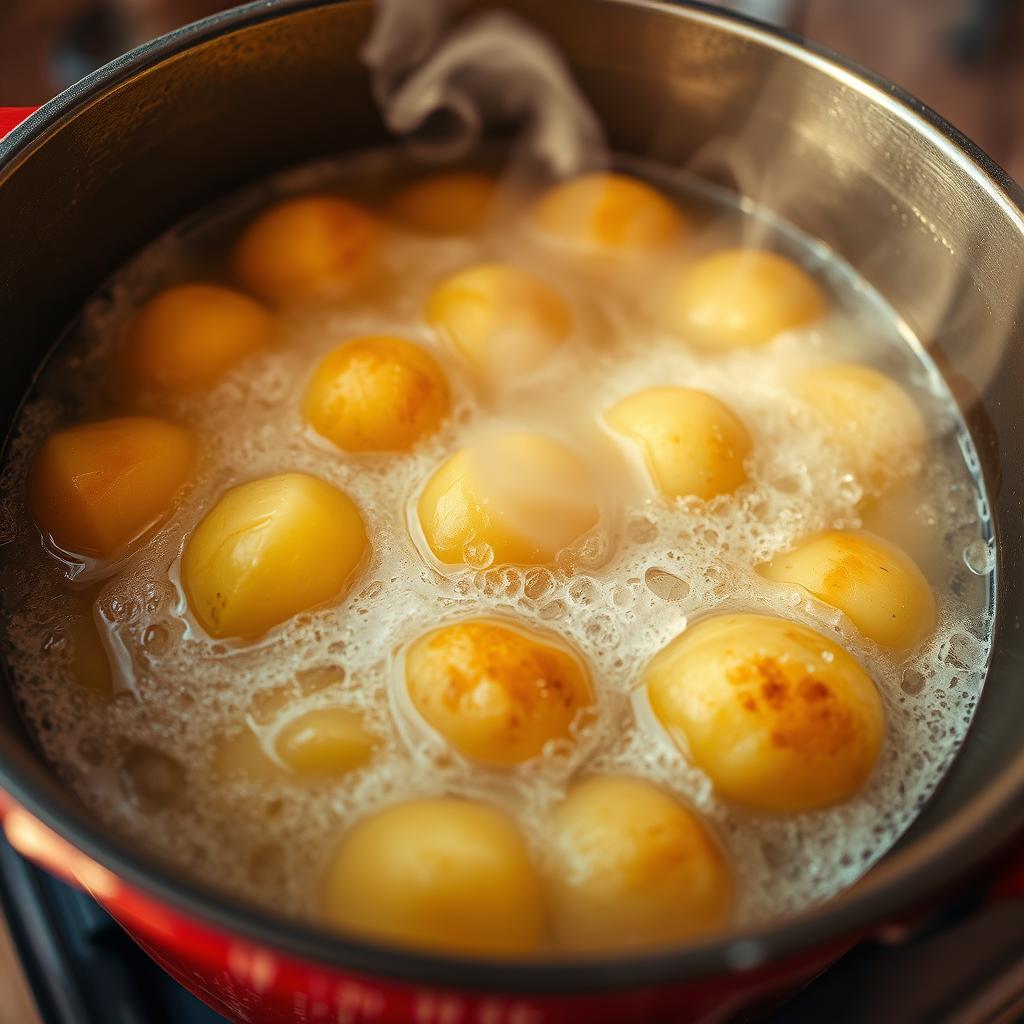
Proper Draining and Drying
After boiling, draining and drying the potatoes are crucial steps that are often overlooked. Proper draining removes excess moisture, while drying helps to achieve a fluffier mash.
To dry the potatoes, return them to the pot over low heat, shaking gently to remove excess moisture.
Incorporating Ingredients for Maximum Flavor
The final step involves incorporating ingredients to achieve maximum flavor. This includes adding butter, milk or cream, and seasonings.
Temperature Timing
The temperature of the ingredients can significantly impact the final result. Warm milk and melted butter help to create a smooth, creamy mash.
Mixing Order and Technique
The order and technique of mixing are also vital. Start by adding butter and gently mashing, then gradually add warm milk until the desired consistency is achieved.
By following these steps and paying attention to temperature timing and mixing order, you can create mashed potatoes that are not only delicious but also visually appealing.
Professional Chef Secrets
The secret to exceptional mashed potatoes lies in the nuances of preparation, a domain where professional chefs excel. By mastering specific techniques, home cooks can elevate their dishes to a professional level.
Temperature Control Mastery
Temperature control is crucial in making perfect mashed potatoes. It involves warming dairy products and maintaining heat during preparation.
Warming Dairy Products
Warming dairy products to the right temperature ensures they incorporate smoothly into the potatoes, enhancing the overall texture.
Maintaining Heat During Preparation
Maintaining a consistent heat during the mashing process prevents the potatoes from becoming too cold or too hot, which can affect their texture.
Texture Perfection Techniques
Achieving the perfect texture is a hallmark of professional mashed potatoes. Techniques such as double-mashing and allowing a resting period are key.
Double-Mashing Method
The double-mashing method involves mashing the potatoes twice, once when they’re boiled and again after they’ve been cooled slightly. This technique ensures a smooth, even texture.
Resting Period Importance
Allowing the mashed potatoes a resting period before serving can help the flavors to meld together and the texture to become even more refined.
By incorporating these professional chef secrets into your cooking routine, you can significantly improve the quality of your mashed potatoes. Temperature control and texture perfection techniques are essential for achieving a dish that’s both delicious and visually appealing.
- Use warmed dairy products for a smoother texture.
- Maintain consistent heat during preparation.
- Apply the double-mashing method for optimal results.
Critical Mistakes to Avoid
To achieve perfect mashed potatoes, it’s crucial to avoid certain pitfalls. Common mistakes can result in a subpar dish, but being aware of these errors can help you create a better culinary experience.
Overprocessing Pitfalls
Overprocessing is a common mistake that can lead to gluey, unappetizing mashed potatoes. Using the right mashing tool and technique can help you avoid this pitfall. Stop mashing once the potatoes are mostly smooth, as overworking the potatoes will release too much starch.
Temperature-Related Errors
Temperature control is vital when preparing mashed potatoes. Adding cold ingredients to hot potatoes can cause the mixture to become lumpy or separated. Ensure that all your ingredients are at room temperature before combining them.
Ingredient Proportion Mistakes
Getting the ingredient proportions right is crucial for achieving the perfect consistency and flavor. Two common mistakes to avoid are adding too much liquid and using insufficient fat.
Too Much Liquid
Adding too much milk or cream can result in a watery, unappetizing mash. Start with a small amount of liquid and add more as needed to achieve the desired consistency.
Insufficient Fat
Using too little butter or other fat can lead to a dry, flavorless mash. Generously add high-quality butter to enrich the flavor and texture of your mashed potatoes.
Creative Flavor Variations
Elevate your mashed potato game with creative flavor variations that will tantalize your taste buds. By incorporating different ingredients and techniques, you can transform a simple side dish into a culinary masterpiece.
French Herb-Infused Options
Infusing mashed potatoes with French herbs adds a sophisticated twist. The choice between fresh and dried herbs can significantly impact the flavor profile.
Fresh vs. Dried Herbs
Fresh herbs like parsley, chives, and thyme provide a vibrant, fresh taste, while dried herbs offer a more concentrated flavor. Experiment with both to find your preferred balance.
Classic French Herb Combinations
Combining herbs like thyme and rosemary or parsley and chives can create complex, aromatic flavors. Try pairing herbs with complementary ingredients to enhance their natural flavors.
Garlic Preparation Methods
Garlic can elevate mashed potatoes, but the preparation method is crucial. Roasting garlic mellows its flavor, making it a rich addition to mashed potatoes. Alternatively, sautéing garlic can enhance its depth.
French Cheese Incorporations
Incorporating French cheese can add richness and depth to mashed potatoes. Different cheeses offer unique flavor profiles.
Comté and Gruyère
Cheeses like Comté and Gruyère are nutty and slightly sweet, making them excellent additions. Mixing these cheeses into mashed potatoes can create a luxurious dish.
Blue Cheese Options
For a bolder flavor, consider adding blue cheese. Its pungency can be balanced with creamy elements, creating a harmonious taste experience.
Gourmet French-Inspired Add-ins
To further enhance your mashed potatoes, consider adding gourmet French-inspired ingredients. Truffle oil or caramelized onions can add depth and sophistication.
Classic French Potato Specialties
In the realm of French cuisine, potatoes are celebrated in various forms, from the elegant pommes purée to the hearty Aligot. These classic dishes not only showcase the versatility of potatoes but also offer inspiration for creating unique mashed potato recipes.
Traditional Pommes Purée
Pommes purée, or French mashed potatoes, is a dish that epitomizes simplicity and elegance. Made with high-quality potatoes, butter, and cream, it requires precise technique to achieve the perfect smooth texture. The key lies in selecting the right potato variety and not over-processing the potatoes.
Aligot: Cheese-Stretched Potatoes
Aligot is a traditional dish from the south of France, known for its creamy texture achieved by mixing mashed potatoes with Tomme de Laguiole cheese. This comforting dish is perfect for special occasions or as a side dish for roasted meats.
Regional French Potato Preparations
France’s diverse regions offer a wide range of potato preparations, each with its unique flavor profile and cooking techniques. Two notable regional influences include:
Normandy Influences
Normandy’s rich dairy products significantly impact its potato dishes, often incorporating cream and butter to create rich, comforting sides.
Provençal Variations
The Provençal region adds a Mediterranean twist to its potato dishes, often using herbs like thyme and rosemary, and sometimes incorporating garlic for added depth.
Perfect Pairing Suggestions
Elevate your dining experience by pairing mashed potatoes with classic French main courses and accompaniments. Mashed potatoes are a versatile side dish that can complement a wide range of flavors.
Traditional French Meat Pairings
French cuisine offers a variety of dishes that pair perfectly with mashed potatoes. Some of the most iconic pairings include:
- Coq au Vin: A classic dish of braised chicken cooked in red wine, mushrooms, and bacon, which pairs exquisitely with creamy mashed potatoes.
- Boeuf Bourguignon: A hearty beef stew cooked in red wine, which is elevated by the comforting texture of mashed potatoes.
- Steak with Sauce au Poivre: A peppercorn-crusted steak served with a creamy sauce, complemented by the smooth texture of mashed potatoes.
Vegetarian French Accompaniments
For vegetarian options, French cuisine doesn’t disappoint. Some delightful pairings include:
- Ratatouille: A vegetable stew from Provence, featuring eggplant, zucchini, and bell peppers, which pairs nicely with the comforting warmth of mashed potatoes.
- Mushroom Preparations: Various French mushroom dishes, such as sautéed mushrooms with garlic and herbs, complement the earthy flavor of mashed potatoes.
By exploring these pairing suggestions, you can create a well-rounded and delicious meal that showcases the best of French cuisine.
Storage and Reheating Expertise
Achieving restaurant-quality mashed potatoes, even when reheated, starts with understanding the best practices for storage and reheating. Proper storage and reheating techniques can significantly impact the final texture and flavor of your mashed potatoes.
Make-Ahead Strategies
Preparing mashed potatoes ahead of time can be a significant advantage when planning meals or events. To make ahead, prepare your mashed potatoes as instructed, then cool them quickly to prevent bacterial growth. Cooling them within 30 minutes to an hour is ideal. Once cooled, transfer them to an airtight container and refrigerate or freeze.
Proper Refrigeration Methods
For short-term storage, refrigeration is the best method. Store your cooled mashed potatoes in an airtight container, ensuring it’s tightly sealed to prevent moisture from entering. Refrigerated mashed potatoes can last for up to 3 to 5 days. When you’re ready to reheat, you’ll have a couple of effective methods to choose from.
Reheating for Restaurant-Quality Results
Reheating mashed potatoes can be done using various techniques, but two of the most effective methods are stovetop and oven reheating.
Stovetop Technique
For stovetop reheating, place your mashed potatoes in a saucepan over low heat. Add a splash of milk or cream to revive their creamy texture. Stir constantly to prevent burning or sticking. This method allows for quick reheating and texture adjustment.
Oven Method
Alternatively, you can reheat mashed potatoes in the oven. Transfer them to an oven-safe dish, cover with foil, and heat at 325°F (165°C) for about 20-30 minutes, or until heated through. You can add extra butter or cream on top before reheating for an extra rich result. For more on preserving other culinary delights, check out tips on storing tomato coulis.
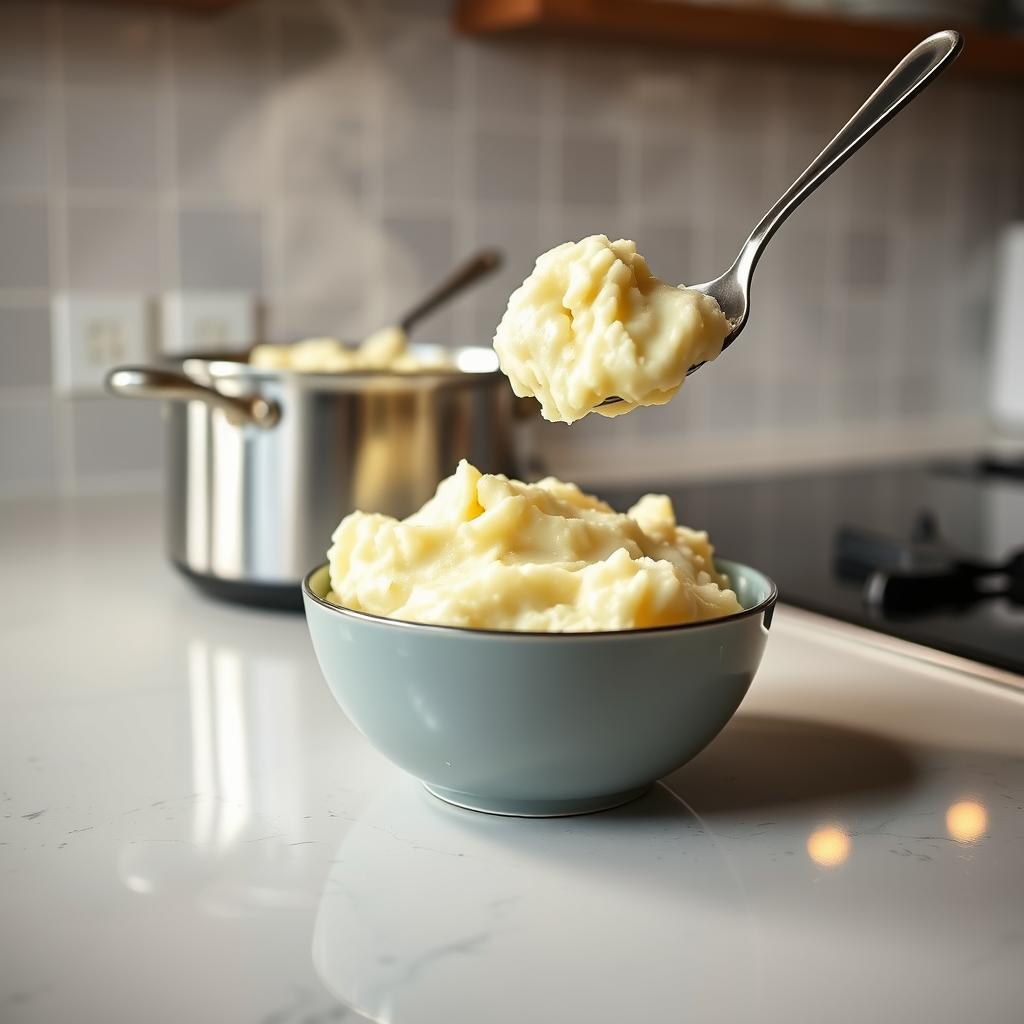
By mastering these storage and reheating techniques, you can enjoy your mashed potatoes at their best, even days after they’re made.
Troubleshooting Guide
Don’t let gluey or watery mashed potatoes ruin your meal; with these troubleshooting tips, you can easily fix common issues.
Common problems like gluey or watery mashed potatoes can be frustrating, but they’re often easy to resolve with the right techniques.
Rescuing Gluey Mashed Potatoes
Gluey mashed potatoes are usually the result of over-mixing or using the wrong potato variety. To fix this, try adding a small amount of warm milk or cream and gently folding it into the potatoes.
Fixing Watery Results
Watery mashed potatoes can be salvaged by adding more mashed potatoes or absorbing the excess moisture with a paper towel. Alternatively, you can try adding a thickening agent like cornstarch or flour.
Eliminating Lumps
Lumps in mashed potatoes can be annoying, but there are several ways to eliminate them.
Manual Methods
One way to remove lumps is to manually break them down with a fork or potato masher until they’re fully incorporated.
Equipment Solutions
For a smoother result, you can use a food mill or blender to break down the lumps and achieve a creamy consistency.
Nutritional Considerations and Adaptations
The nutritional profile of traditional mashed potatoes provides a foundation for creating healthier alternatives. Mashed potatoes, when prepared with whole potatoes, milk, and moderate amounts of butter, can be a relatively balanced side dish.
Traditional Recipe Nutrition Profile
A classic mashed potato recipe is high in carbohydrates and can be rich in calories due to the addition of butter and milk. A serving can contain approximately 150-200 calories, with a significant portion coming from the potatoes themselves. Understanding this nutritional profile is key to making informed adaptations.
Lighter French-Inspired Alternatives
To create a lighter version, consider using less butter and substituting with olive oil or other healthier fats. Using low-fat milk or dairy alternatives can also reduce calorie content. For a French twist, incorporate herbs like chives or parsley for added flavor without extra calories.
Accommodating Dietary Restrictions
Mashed potatoes can be adapted for various dietary needs. For lactose intolerance, consider lactose-free milk or vegan butter substitutes.
Lactose-Free Options
Lactose-free milk or almond milk can be used as substitutes in mashed potatoes, allowing those with lactose intolerance to enjoy the dish.
Gluten-Free Considerations
Traditional mashed potatoes are naturally gluten-free, making them a suitable side dish for those with gluten intolerance or sensitivity. Be cautious with added ingredients like certain types of broth or seasonings that may contain gluten.
Conclusion: Perfecting Your Mashed Potato Mastery
Achieving mashed potato mastery requires practice, patience, and attention to detail. By following the techniques outlined in the previous sections, cooks can perfect their recipe and create delicious, creamy mashed potatoes that are sure to impress.
The key to success lies in understanding the science behind the dish, selecting the right ingredients, and mastering the preparation method. With these skills, home cooks can elevate their mashed potato game and create a truly French culinary experience.
By incorporating the tips and techniques discussed, cooks can refine their skills and achieve mashed potato mastery. Whether you’re a seasoned chef or a beginner in the kitchen, the art of making perfect mashed potatoes is within reach. With practice and dedication, you’ll be creating mouth-watering mashed potatoes that will become a staple in your culinary repertoire.
FAQ
What is the best potato variety for making mashed potatoes?
French potato varieties, such as those high in starch, are ideal for making creamy mashed potatoes.
How do I achieve the perfect texture in my mashed potatoes?
Understanding the science behind texture and creaminess, and using techniques like double-mashing, can help achieve perfect results.
What is the role of butter and dairy in mashed potatoes?
Premium butter and dairy options, such as those used in French cuisine, add richness and flavor to mashed potatoes.
How do I prevent overprocessing my mashed potatoes?
Being aware of the pitfalls of overprocessing and using the right mashing tools can help prevent a gluey or unappetizing texture.
Can I make mashed potatoes ahead of time?
Yes, using make-ahead strategies and proper refrigeration methods can help achieve restaurant-quality results when reheating.
How do I fix common issues with mashed potatoes, such as gluey or watery results?
Understanding the solutions to common problems, such as rescuing gluey mashed potatoes or fixing watery results, can help salvage your dish.
What are some creative flavor variations for mashed potatoes?
Incorporating French herb-infused options, garlic preparation methods, and gourmet French-inspired add-ins can create unique and delicious flavor variations.
How do I pair mashed potatoes with other dishes?
Traditional French meat pairings and vegetarian French accompaniments can provide inspiration for creating a well-rounded and delicious meal.
Can I adapt mashed potatoes to accommodate dietary restrictions?
Yes, understanding the nutritional profile of traditional mashed potatoes and exploring lighter French-inspired alternatives can help accommodate dietary restrictions.
What are some classic French potato specialties that I can try?
Traditional pommes purée, Aligot, and regional French potato preparations offer inspiration for creating unique and delicious mashed potatoes.
How do I store and reheat mashed potatoes to maintain their quality?
Proper refrigeration methods and reheating techniques, such as those used in professional kitchens, can help maintain the quality of mashed potatoes.
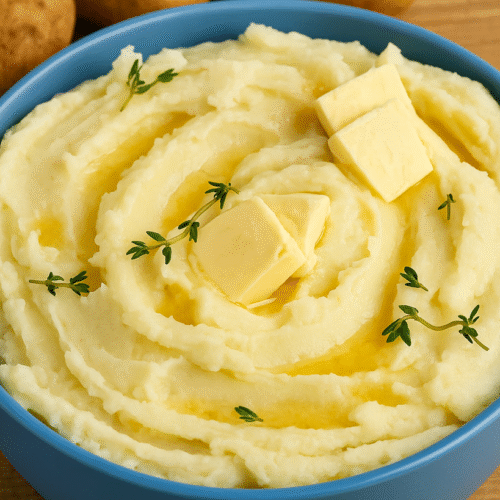
The BEST Mashed Potatoes Recipe
Ingredients
- 4 pounds potatoes russet or Yukon gold
- 3 cloves garlic optional
- 1/3 cup melted salted butter
- 1 cup milk or cream
- Salt to taste
- Black pepper to taste
Instructions
- Peel and quarter the potatoes, place in a large pot of cold salted water.
- Add garlic cloves if using and bring to a boil. Cook uncovered for about 15 minutes, until fork-tender.
- Drain well and return potatoes to the warm pot to remove excess moisture.
- Heat the milk/cream in the microwave or saucepan until warm.
- Add melted butter to the potatoes and begin mashing. Gradually add the heated milk until desired consistency is reached.
- Season with salt and black pepper. Serve hot.
Notes
- Calories: 209 kcal
- Carbohydrates: 34 g
- Protein: 5 g
- Fat: 7 g
- Saturated Fat: 4 g
- Cholesterol: 17 mg
- Sodium: 74 mg
- Potassium: 798 mg
- Fiber: 2 g
- Sugar: 2 g

